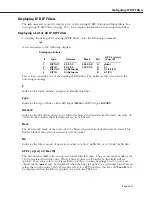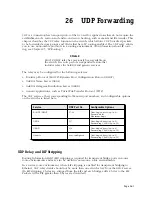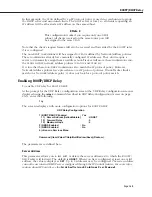
BOOTP/DHCP Relay
Page 26-4
BOOTP/DHCP Relay
The switch supports a
UDP
relay function that allows Bootstrap Protocol (
BOOTP
) and
Dynamic Host Configuration Protocol (
DHCP
) packets to pass between AutoTracker Groups.
♦
Note
♦
A
BOOTP
/
DHCP
relay may be configured for authenti-
cated groups as well. See
BOOTP/DHCP Relay and
Authentication
on page 26-5 and the Authentication
Services chapter of the
Switched Network Solutions User
Manual
.
Through UI software, you can turn the relay function on or off and specify the IP addresses of
DHCP
servers, the delay before the relay forwards a request, and the maximum number of
hops a packet may be forwarded through the network.
Alternately the relay function may be provided by an external router connected to the switch;
in this case, the relay would be configured on the external router.
Overview of DHCP
DHCP
provides a framework for passing configuration information to Internet hosts on a
TCP/
IP
network. It is based on the Bootstrap Protocol (
BOOTP
), adding the ability to automatically
allocate reusable network addresses and additional configuration options.
DHCP
consists of
the following two components:
• A protocol for delivering host-specific configuration parameters from a
DHCP
server to a
host.
• A mechanism for allocating network addresses to hosts.
DHCP
is built on a client-server model in which a designated
DHCP
server allocates network
addresses and delivers configuration parameters to dynamically configured hosts. It supports
the following three mechanisms for IP address allocation:
Automatic
DHCP
assigns a permanent IP address to a host.
Dynamic
DHCP
assigns an IP address to a host for a limited period of time (or until the
host explicitly relinquishes the address).
Manual
The network administrator assigns a host’s IP address and
DHCP
simply
conveys the assigned address to the host.
A particular network will use one or more of these mechanisms, depending on the policies of
the network administrator.
For information about configuring
DHCP
servers, see the IP Control chapter of the
Switched
Network Solutions User Manual
.
DHCP and the OmniS/R
The unique characteristics of the
DHCP
protocol require a good plan before setting up the
switch in a
DHCP
environment. Since
DHCP
clients initially have no IP address, placement of
these clients in an AutoTracker
VLAN
is hard to determine. In simple networks (i.e., one
group, one
VLAN
) AutoTracker rules do not need to be deployed to support the
BOOTP/DHCP
relay functionality.
Summary of Contents for Omni Switch/Router
Page 1: ...Part No 060166 10 Rev C March 2005 Omni Switch Router User Manual Release 4 5 www alcatel com ...
Page 4: ...page iv ...
Page 110: ...WAN Modules Page 3 40 ...
Page 156: ...UI Table Filtering Using Search and Filter Commands Page 4 46 ...
Page 164: ...Using ZMODEM Page 5 8 ...
Page 186: ...Displaying and Setting the Swap State Page 6 22 ...
Page 202: ...Creating a New File System Page 7 16 ...
Page 270: ...Displaying Secure Access Entries in the MPM Log Page 10 14 ...
Page 430: ...OmniChannel Page 15 16 ...
Page 496: ...Configuring Source Route to Transparent Bridging Page 17 48 ...
Page 542: ...Dissimilar LAN Switching Capabilities Page 18 46 ...
Page 646: ...Application Example DHCP Policies Page 20 30 ...
Page 660: ...GMAP Page 21 14 ...
Page 710: ...Viewing the Virtual Interface of Multicast VLANs Page 23 16 ...
Page 722: ...Application Example 5 Page 24 12 ...
Page 788: ...Viewing UDP Relay Statistics Page 26 24 ...
Page 872: ...The WAN Port Software Menu Page 28 46 ...
Page 960: ...Deleting a PPP Entity Page 30 22 ...
Page 978: ...Displaying Link Status Page 31 18 ...
Page 988: ...Displaying ISDN Configuration Entry Status Page 32 10 ...
Page 1024: ...Backup Services Commands Page 34 14 ...
Page 1062: ...Diagnostic Test Cable Schematics Page 36 24 ...
Page 1072: ...Configuring a Switch with an MPX Page A 10 ...
Page 1086: ...Page B 14 ...
Page 1100: ...Page I 14 Index ...
















































